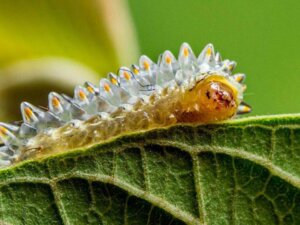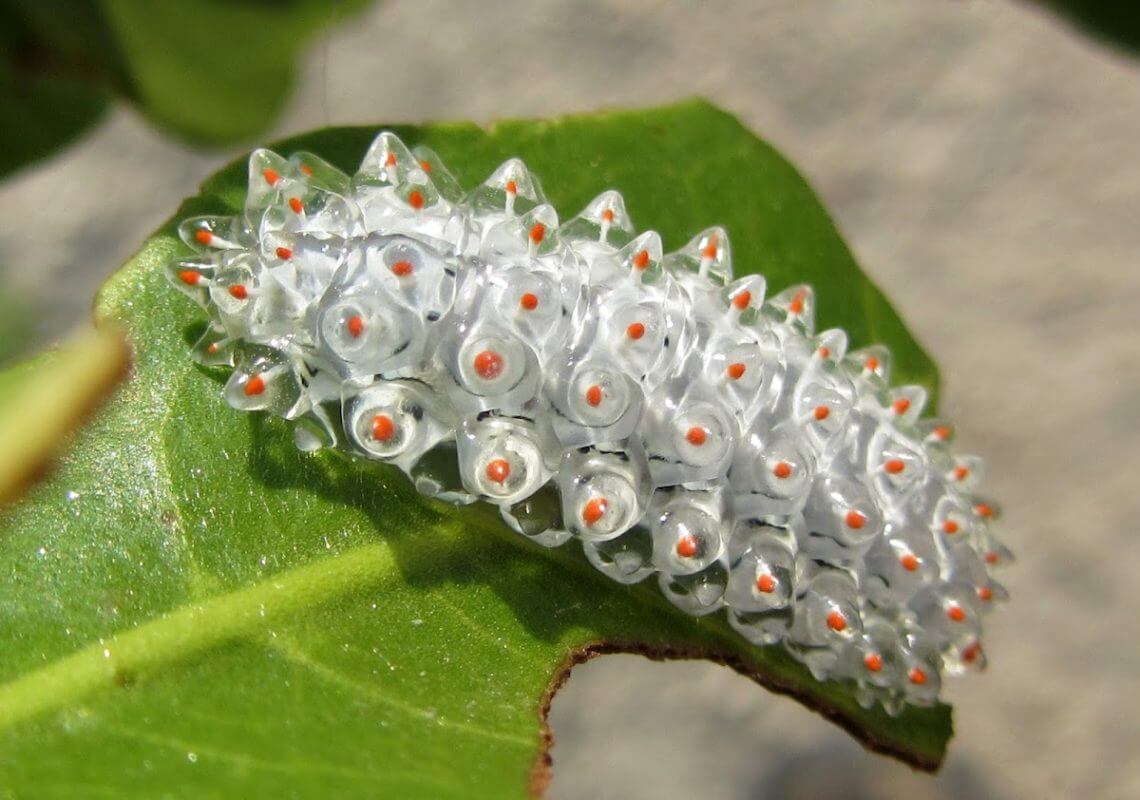The Acraga Coa: Habitat, Characteristics and Curiosities


Written and verified by the biologist Georgelin Espinoza Medina
There are a wealth of beautiful insects, some dazzle with their bright colors, others with their striking designs. Among them stands out a lepidopteran considered one of the most beautiful, not only in America, but in the whole world. It’s the species acraga coa, which in its juvenile stage is called crystal caterpillar, do you know it?
It belongs to the Dalceridae family, which includes 15 genera and 79 species. This fascinating animal inhabits part of Central America. In this article, we’ll bring you all the details discovered about it, since it’s a very enigmatic and little-known invertebrate.
Habitat and distribution of acraga coa
The lepidopteran is found in the American continent, in dry, humid, tropical and subtropical forests. It ranges from southern Mexico to some Central American countries, such as Belize, Guatemala, El Salvador, Honduras, Costa Rica and Panama.
Characteristics of acraga coa
Like Lepidoptera and many other insects, this species goes through several stages in its cycle until it becomes a beautiful moth. The following are the characteristics of each stage.
Eggs
The size of the eggs of the members of Dalceridae are very small, only about one millimeter in length. They’re smooth, oblong in shape and usually light-colored. Females can lay hundreds of eggs, which will hatch in 8 to 10 days.
Glass caterpillar
The caterpillar looks like a slug, with an approximate size of about 20 millimeters (just under an inch). Its coloration is greenish, and semitransparent, to which it owes its common name. The upper part of its body is full of protuberances, which have a spot of intense color (reddish-orange) on each one, which gives it a beautiful appearance.
Pupa
When it’s close to the pupa stage, the coloration of this specimen becomes darker. It wraps itself in a silky cocoon, created by itself. In this way, it’s able to defend itself from its enemies while it’s in this period of inactivity.
Moth
When it reaches its adult stage, its size is different in females and males. Males measure between 12 and 18 millimeters in length in their forewings and females are slightly larger, measuring between 19 and 25 millimeters.
The moth’s appearance is velvety, thanks to the fact that it’s covered with hairs. Its wings have shades of yellow-orange to reddish-brown, but with lighter (yellow) veins, which creates a contrast.
Food
This species consumes plants, especially their leaves. Its diet includes a variety of specimens from different families, including citrus and coffee trees. The larvae position themselves on the underside of the lamina or underside and feed there. The adults stand on the upper side and prefer the newest leaves.
Curiosities of acraga coa

Although we don’t know too much about the life of this “glass” caterpillar, we bring you 5 interesting curiosities of this species.
1. They’re called slug caterpillars
During the larva stage, they have a slimy body, so they’re also known as slug caterpillars. This aspect is thought to work as a defense against predators.
2. Their bumps are easily detached
The upper part of the caterpillar’s body has bumps that easily fall off. It’s also believed that this characteristic works as a defensive method, because it’s used to gain time to escape from predators, although this hasn’t yet been scientifically verified.
3. It isn’t poisonous
Although this species has intense colorations that could make it look like a poisonous organism, so far no toxic substance or compound has been discovered in its body. Thus, it’s a non-hazardous specimen.
4. They have a pair of accessory glands
The females of members of the family Dalceridae are characterized by having two secondary accessory glands, the secretion of which is apparently useful during laying. Thus, as eggs are laid, fluid is excreted from these structures and provides protection for them.
5. Their conservation status is unknown
At present, there’s a lack of knowledge about the conservation status of many species of living beings. One of the animals that hasn’t been studied too much is this unique moth. There’s still a long way to go to complete our understanding of its behavior and biology, as well as that of other important animal specimens.
In summary, the species acraga coa is indeed fascinating. Small, but beautiful, both during its larval stage, when it’s the glass caterpillar, as well as in its adult period as a velvet moth. However, much remains to be discovered about the life of this insect, which makes it a very enigmatic animal from the Americas.
There are a wealth of beautiful insects, some dazzle with their bright colors, others with their striking designs. Among them stands out a lepidopteran considered one of the most beautiful, not only in America, but in the whole world. It’s the species acraga coa, which in its juvenile stage is called crystal caterpillar, do you know it?
It belongs to the Dalceridae family, which includes 15 genera and 79 species. This fascinating animal inhabits part of Central America. In this article, we’ll bring you all the details discovered about it, since it’s a very enigmatic and little-known invertebrate.
Habitat and distribution of acraga coa
The lepidopteran is found in the American continent, in dry, humid, tropical and subtropical forests. It ranges from southern Mexico to some Central American countries, such as Belize, Guatemala, El Salvador, Honduras, Costa Rica and Panama.
Characteristics of acraga coa
Like Lepidoptera and many other insects, this species goes through several stages in its cycle until it becomes a beautiful moth. The following are the characteristics of each stage.
Eggs
The size of the eggs of the members of Dalceridae are very small, only about one millimeter in length. They’re smooth, oblong in shape and usually light-colored. Females can lay hundreds of eggs, which will hatch in 8 to 10 days.
Glass caterpillar
The caterpillar looks like a slug, with an approximate size of about 20 millimeters (just under an inch). Its coloration is greenish, and semitransparent, to which it owes its common name. The upper part of its body is full of protuberances, which have a spot of intense color (reddish-orange) on each one, which gives it a beautiful appearance.
Pupa
When it’s close to the pupa stage, the coloration of this specimen becomes darker. It wraps itself in a silky cocoon, created by itself. In this way, it’s able to defend itself from its enemies while it’s in this period of inactivity.
Moth
When it reaches its adult stage, its size is different in females and males. Males measure between 12 and 18 millimeters in length in their forewings and females are slightly larger, measuring between 19 and 25 millimeters.
The moth’s appearance is velvety, thanks to the fact that it’s covered with hairs. Its wings have shades of yellow-orange to reddish-brown, but with lighter (yellow) veins, which creates a contrast.
Food
This species consumes plants, especially their leaves. Its diet includes a variety of specimens from different families, including citrus and coffee trees. The larvae position themselves on the underside of the lamina or underside and feed there. The adults stand on the upper side and prefer the newest leaves.
Curiosities of acraga coa

Although we don’t know too much about the life of this “glass” caterpillar, we bring you 5 interesting curiosities of this species.
1. They’re called slug caterpillars
During the larva stage, they have a slimy body, so they’re also known as slug caterpillars. This aspect is thought to work as a defense against predators.
2. Their bumps are easily detached
The upper part of the caterpillar’s body has bumps that easily fall off. It’s also believed that this characteristic works as a defensive method, because it’s used to gain time to escape from predators, although this hasn’t yet been scientifically verified.
3. It isn’t poisonous
Although this species has intense colorations that could make it look like a poisonous organism, so far no toxic substance or compound has been discovered in its body. Thus, it’s a non-hazardous specimen.
4. They have a pair of accessory glands
The females of members of the family Dalceridae are characterized by having two secondary accessory glands, the secretion of which is apparently useful during laying. Thus, as eggs are laid, fluid is excreted from these structures and provides protection for them.
5. Their conservation status is unknown
At present, there’s a lack of knowledge about the conservation status of many species of living beings. One of the animals that hasn’t been studied too much is this unique moth. There’s still a long way to go to complete our understanding of its behavior and biology, as well as that of other important animal specimens.
In summary, the species acraga coa is indeed fascinating. Small, but beautiful, both during its larval stage, when it’s the glass caterpillar, as well as in its adult period as a velvet moth. However, much remains to be discovered about the life of this insect, which makes it a very enigmatic animal from the Americas.
All cited sources were thoroughly reviewed by our team to ensure their quality, reliability, currency, and validity. The bibliography of this article was considered reliable and of academic or scientific accuracy.
- Aiello, A., Rodríguez, V., Becker, V., & Greece, O. (2005). Moths and butterflies (Lepidoptera) from Bahia Honda and Canales de Tierra island (Veraguas, Panamá). www.liquidjunglelab.com/wp-content/uploads/2016/05/moths_butterflies.pdf
- Miller, S. (1993). Unique Secondary “Accessory Glands” in the female genitalia of Dalceridae (Lepidoptera). Annals of the Entomological Society of America, 86(2), 179-181. https://academic.oup.com/aesa/article/86/2/179/67750?login=true
- Miller, S. (1994). Systematics of the Neotropical moth family Dalceridae (Lepidóptera). https://www.biodiversitylibrary.org/partpdf/26473
This text is provided for informational purposes only and does not replace consultation with a professional. If in doubt, consult your specialist.








